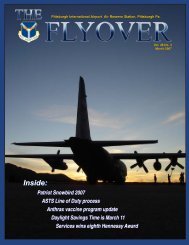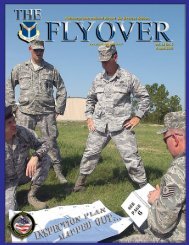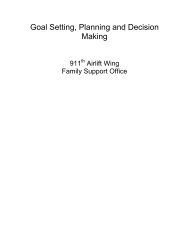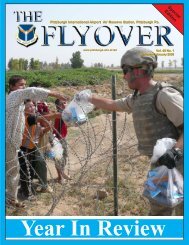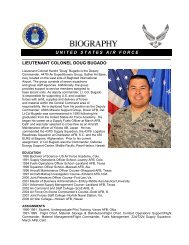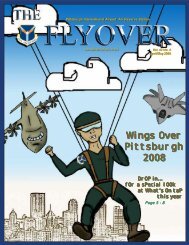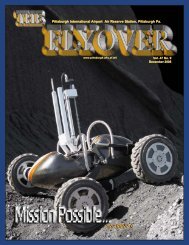January - Pittsburgh IAP Air Reserve Station
January - Pittsburgh IAP Air Reserve Station
January - Pittsburgh IAP Air Reserve Station
- No tags were found...
Create successful ePaper yourself
Turn your PDF publications into a flip-book with our unique Google optimized e-Paper software.
The FlyoverHealth/Sports<strong>January</strong> 2007 11Achieving, maintaining a healthy weight in the New YearBy Mary CalvagnaHealth Gate Data Corp.You may have heard that losing weight is as easyas eating less and exercising more. Well it’s true—taking in fewer calories than you use each day is thesimplest way to lose weight. Never mind the faddiets, weight-loss pills, and zany herbalremedies—it all comes down to abalanced diet and a regular exerciseprogram.Using the Body Mass Index:The first step is determining yourcurrent weight status: Are youunderweight, normal weight, overweight, orobese?A good measure for this is the BodyMass Index (BMI), a standardized methodused by many health professionals toevaluate weight and body fat. BMI iscalculated by dividing weight in kilograms byheight in meters squared.It gives you an indication of whether youare at risk of health problems that arerelated to being overweight or obese. If yourBMI is 25 or higher, you are at risk for anumber of serious health problems, includinghigh blood pressure, high cholesterol, heartdisease, stroke, type 2 diabetes, andosteoarthritis.To find your weight in kilograms, multiplyyour weight in pounds by 0.45.For example:If your weight is 130 pounds: 130 x 0.45 =58.5. Your weight is kilograms is 58.5.To find your height in meters, multiply yourheight in inches by 0.0254. For example:If your height is 5’6", that is 66 inches: 66 x 0.0254= 1.6764. Your height in meters is 1.6764.To square the number, multiply it by itself: 1.6764 x1.6764 = 2.81For the example above, the BMI is: 58.97 dividedby 2.81 = 20.98BMI values are interpreted as follows:• 18.4 or less = underweight• 18.5 to 24.9 = normal weight• 25 to 29.9 = overweight• 30 and over = obeseAlthough this is a reliable method, it is notfoolproof. Because muscle tissue weighs more thanfat tissue, heavily muscled people may fall into theobese range when they are not obese.Eating a Healthful Diet:To lose weight, you need to take in fewer caloriesthan you use—this is where your diet comes in. Itmay be in need of an overhaul. But, you don’t wantto lower your calories at the expense of nutrition. Tolearn more about developing a healthful diet thatis right for you, read our article on the latestfood guide pyramid: Unlocking the Secretsof the New Food Pyramid.Try not to think of your new eating habitsas “going on a diet,” instead, think of it as alifestyle change. Adding more fruits, vegetables,and whole grains to your diet and cutting back onsaturated fat and cholesterol are good for you nomatter what your age. Creating a healthful dietthat you can stick to throughout your life will helpyou achieve and maintain your desired weight.Getting Regular Exercise:To lose weight, you need to use more caloriesthan you take in—this is where exercise comes in.Not only does regular exercise help you get to anideal weight, it can help you stay there too. If youdon’t exercise already, it is time to get started. Agood goal for many people to work up to isexercising 4 to 6 times a week for 30 to 60minutes at a time. If you are not sure how tobegin, read our tipsheet: Starting a RegularExercise Program.There are several different typesof exercise that you can do. Anideal exercise programcombines four types ofexercise:• Aerobic• Weight-bearing• Strength training• StretchingIt is a good idea to talk with your doctor beforebeginning an exercise program.No Time Like Today:Now that you have the tools, getting started is up toyou. Start slowly, have carrots or an apple for a snack,instead of a bag of chips. And take a walk around theblock before or after work today. Just remember, thesooner you begin working toward your ideal weight,the sooner you can reap the healthful benefits.



